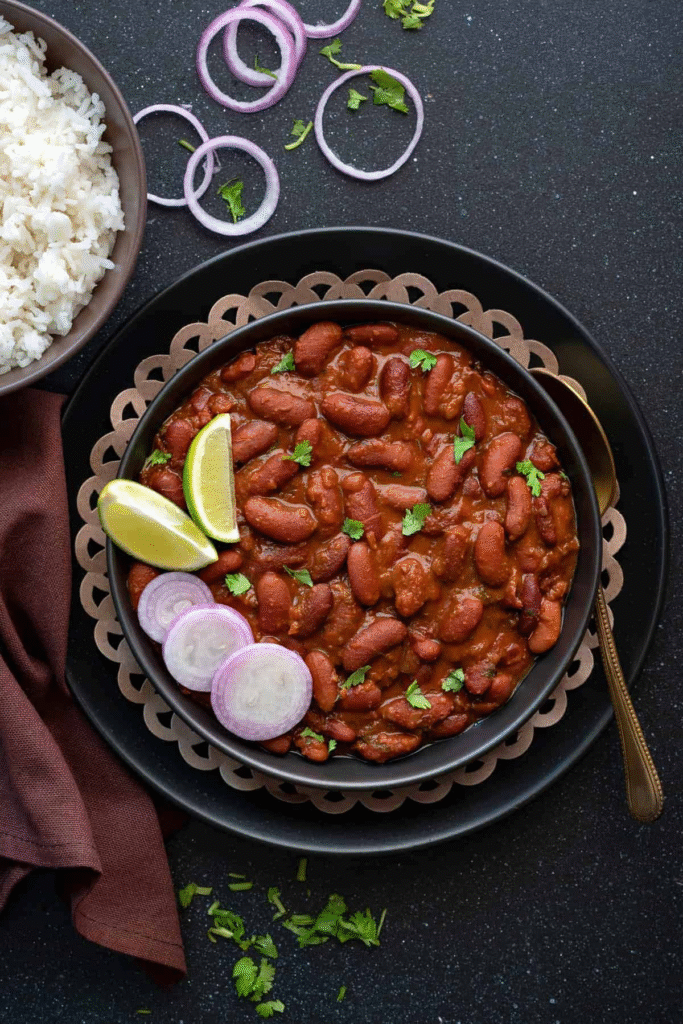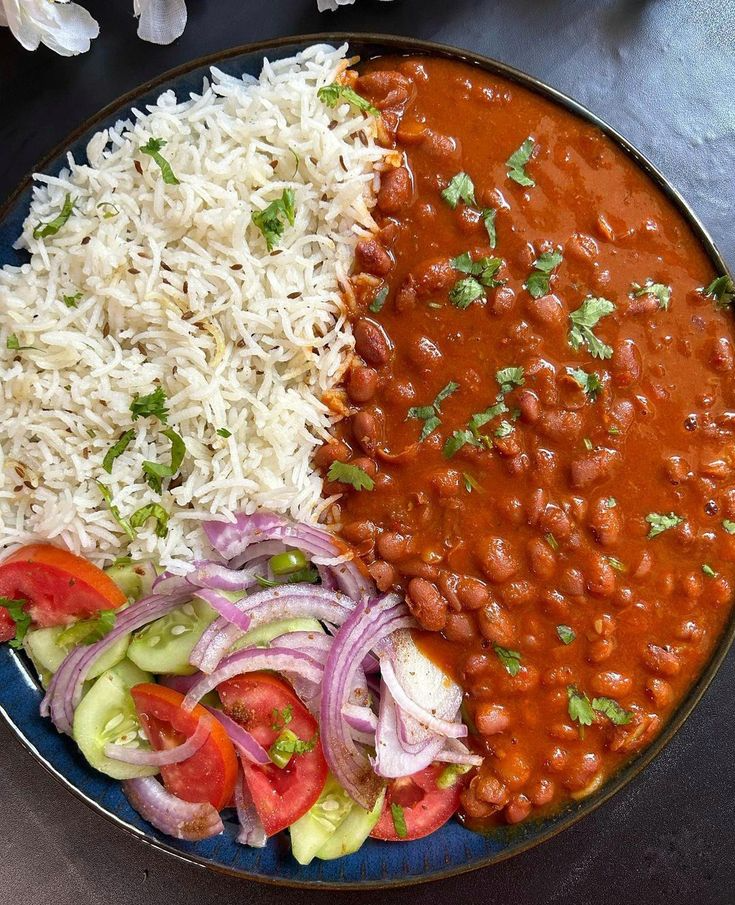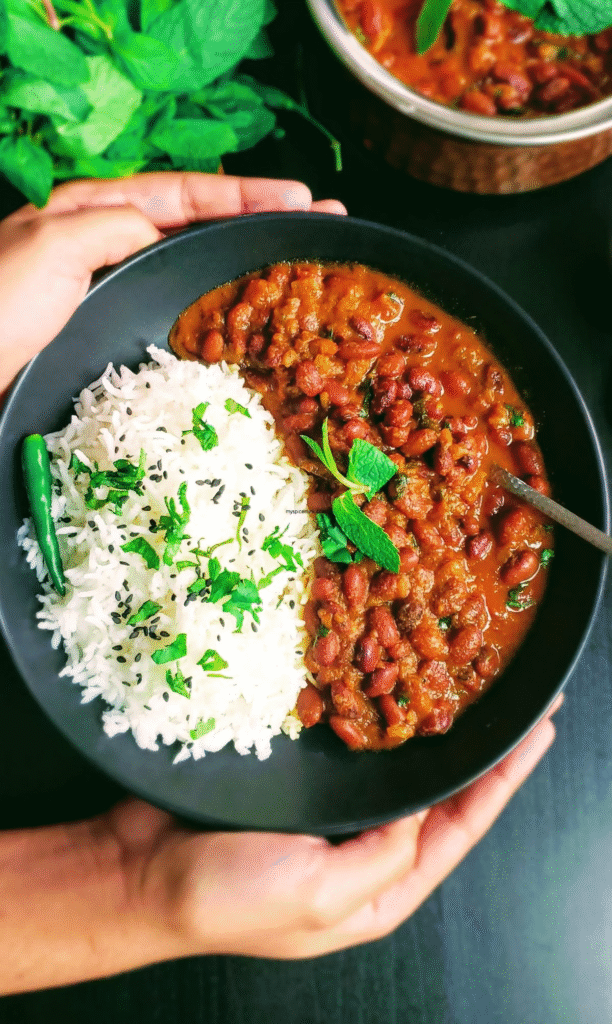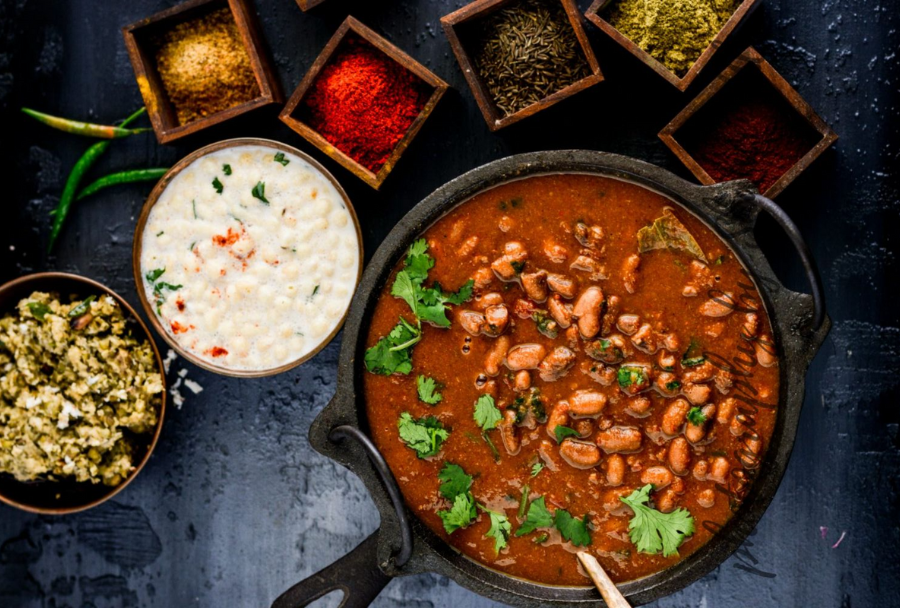Rajma Masala is one of the most loved comfort foods in Indian cuisine — a hearty, mildly spiced, and flavorful curry made with tender red kidney beans simmered in a rich tomato-onion gravy. It’s the perfect dish to serve on a cozy weekend lunch, festive meal, or whenever you want to enjoy a wholesome, satisfying meal with your family.
Rajma Masala is one of those timeless dishes that instantly evokes warmth, comfort, and the aroma of a traditional Indian kitchen. With its roots deeply embedded in the northern regions of India, especially Punjab, this dish has become more than just a regular curry—it’s a symbol of home-style cooking, childhood nostalgia, and soulful nourishment. A harmonious combination of tender red kidney beans simmered in a thick, spiced tomato and onion gravy, Rajma Masala is much more than a simple bowl of legumes. It tells a story of culture, patience, and the magic that happens when humble ingredients are treated with care and cooked with love.
Often served with a generous portion of steamed basmati rice, popularly known as “Rajma Chawal,” this dish transcends class, age, and occasion. Whether it’s a rainy afternoon, a weekend family lunch, or a festive spread, Rajma Masala finds a cherished spot on the Indian dining table. The comforting nature of the dish lies in its simplicity. Despite using readily available ingredients, it delivers an explosion of flavor that is robust, slightly tangy, mildly spicy, and deeply satisfying. The slow-cooked nature of the curry allows the kidney beans to absorb all the spices, resulting in a thick, luscious gravy that clings to every grain of rice or bite of roti.
The charm of Rajma Masala lies in its versatility and ability to bridge regional and global palates. In Punjab, the preparation is slightly richer, with ghee or butter often added to enhance the taste. In other regions, it may be made lighter, more tomato-forward, or even vegan. No matter the variation, the essence remains the same—a hearty bowl of beans immersed in a spicy, aromatic sauce. For many Indians, especially those living abroad, Rajma Masala is the ultimate comfort food. It’s the dish they crave when homesick, when unwell, or when celebrating a small victory in a foreign land.
Preparing this dish isn’t just about following a recipe—it’s a ritual. It starts with soaking the red kidney beans overnight, allowing them to soften and cook evenly the next day. Then comes the tempering of spices in oil—cumin seeds spluttering, onions browning to perfection, ginger and garlic releasing their earthy aroma, and tomatoes melting down into a rich base.
The spices—turmeric, coriander, garam masala, and red chili—blend into this mix, creating a base that’s as fragrant as it is flavorful. Once the soaked beans are added, they are simmered slowly, sometimes for over an hour, until the gravy thickens and the beans turn buttery soft. This slow process is the soul of the dish—it teaches patience and rewards with depth of flavor.
What’s also noteworthy is Rajma Masala’s nutritional profile. Red kidney beans are packed with plant-based protein, fiber, iron, and essential minerals. They aid in digestion, help stabilize blood sugar, and provide long-lasting energy. The dish, when cooked with minimal oil and served with brown rice or whole wheat bread, becomes a complete and balanced meal. For vegetarians and vegans, it’s an excellent source of nutrition, especially when paired with other legumes or lentils throughout the week.
The cultural importance of Rajma Masala goes beyond taste. In many North Indian households, Sunday lunch is incomplete without a steaming plate of rajma chawal. It’s not just about food, but about togetherness, tradition, and taking a break from the week’s hustle. Many people have childhood memories of walking into the house and being hit with the unmistakable aroma of Rajma bubbling away on the stove. It’s a dish that unites generations, with grandmothers, mothers, and children all agreeing on its unbeatable comfort.
Today, Rajma Masala continues to evolve. Chefs experiment by adding coconut milk for creaminess, using smoked tomatoes for a deeper flavor, or incorporating it into fusion dishes like burritos and tacos. Yet, the classic preparation still reigns supreme. It’s that go-to recipe passed down through families, scribbled in diaries, and stored in memory. It represents a connection to roots, to tradition, and to the sheer joy that a bowl of well-made food can bring.
In essence, Rajma Masala is more than just an Indian curry. It’s a cultural icon, a culinary tradition, and a bowl of pure comfort. With its rich gravy, hearty texture, and bold spices, it embodies everything we love about Indian food—flavor, depth, and heart. Whether you’re discovering it for the first time or cooking it for the hundredth, each spoonful feels like coming home.
Originating from North India, Rajma Masala holds a special place in Punjabi households and beyond. It became a staple in Indian kitchens thanks to its comforting flavor and high protein content, often served with steamed rice — a combo fondly called Rajma Chawal.
In this article, we’ll guide you through how to make an authentic yet easy Rajma Masala at home, with simple ingredients and step-by-step instructions that give you irresistible, homestyle results.
What is Rajma Masala?

Rajma Masala is a mildly spiced Indian curry made with red kidney beans (rajma) cooked in an onion-tomato gravy. The beans are soaked overnight and pressure-cooked until soft, then simmered slowly with aromatic spices to create a dish that’s as nutritious as it is flavorful.
Rajma Masala is a popular Indian curry made with red kidney beans simmered in a thick, spicy, and aromatic tomato-onion gravy. The name “Rajma” refers to the red kidney beans, while “Masala” signifies the robust blend of spices used to create the rich and flavorful curry base. This dish is a staple in North Indian households, especially in the Punjab region, where it’s often paired with steamed basmati rice to form the iconic comfort food combo known as Rajma Chawal.
The preparation of Rajma Masala begins by soaking dried red kidney beans overnight, which not only helps soften them but also ensures that they cook evenly. The next day, the beans are boiled until tender and then combined with a slow-cooked masala made from finely chopped onions, tomatoes, ginger, garlic, and a harmonious mix of spices like cumin, coriander, turmeric, garam masala, and red chili powder. Some versions also include a touch of kasuri methi (dried fenugreek leaves) to enhance the aroma and flavor.
One of the hallmarks of Rajma Masala is its luscious, velvety gravy that develops as the kidney beans simmer gently in the spiced tomato base. As they cook, the beans absorb the flavors of the masala, creating a curry that’s rich, deep, and satisfying. Despite its relatively simple ingredient list, the dish offers layers of taste—from tangy and slightly sweet notes of tomatoes to the earthy, warming tones of the spices.
What sets Rajma Masala apart is its comfort-food appeal. It’s filling, flavorful, and deeply nourishing—perfect for everything from weekday dinners to celebratory feasts. The dish is also high in plant-based protein and fiber, making it a wholesome option for vegetarians and vegans. Kidney beans are known for their health benefits, including improved digestion, sustained energy, and heart health. When cooked with minimal oil and served with brown rice or whole wheat rotis, Rajma Masala becomes a nutritious, balanced meal.
Beyond its health benefits, Rajma Masala carries immense cultural significance. In many North Indian homes, it’s considered a weekend or special-occasion dish, often enjoyed as part of a leisurely lunch with family. Its popularity has spread far beyond its regional roots, making it a beloved part of Indian cuisine both domestically and internationally. Restaurants, tiffin services, and home cooks across the globe recognize its universal appeal.
In essence, Rajma Masala is much more than just a bean curry. It’s a celebration of Indian culinary tradition, a tribute to slow cooking, and a bowl of comfort that brings people together. Whether you’re enjoying it on a cold evening, as a nostalgic reminder of home, or simply to explore new flavors, this dish always leaves a lasting impression.
Traditionally, it’s served with steamed basmati rice — a combination so iconic that “rajma chawal” is practically a dish in itself.
Rajma Masala is more than just a curry — it’s a story simmering in every Indian kitchen. With deep roots in North Indian cuisine, particularly Punjabi households, this dish has evolved into one of the most beloved and iconic comfort foods in India. At its heart, Rajma Masala is a red kidney bean curry infused with aromatic spices and slow-cooked until the beans melt into the thick, flavorful gravy. But its charm extends beyond ingredients — it’s a dish that brings families together, holds cultural sentiment, and adapts beautifully across kitchens, diets, and regions.
🧄 The Cooking Process: A Ritual of Love
The preparation of Rajma Masala is a patient and rewarding process. It begins with soaking dried red kidney beans overnight, which not only softens them but helps reduce cooking time and enhances their digestibility. The next step is boiling these beans until tender — this can be done using a pressure cooker or a slow simmering pot. What makes this dish shine is the masala base: a combination of finely chopped onions, ripe tomatoes, fresh ginger, garlic, and a careful blend of ground spices. Common spices include turmeric, cumin, coriander, red chili powder, and garam masala, each adding depth and balance to the curry.
Once the base is cooked until oil separates and the flavors intensify, the cooked kidney beans are added along with some of their cooking water. The curry is simmered gently so that the beans soak up all the spicy flavors and the gravy thickens to a creamy consistency. Garnished with coriander leaves and often topped with a dollop of ghee or butter, the final dish is soul-satisfying.
🌍 Regional and Cultural Variations
While the Punjabi Rajma Masala is the most widely recognized version — hearty, spicy, and slightly creamy — variations exist across India and even outside it. In Himachal Pradesh and Uttarakhand, people use more local kidney bean varieties and sometimes add yogurt or regional masalas. In Nepali cuisine, a similar preparation called Rajma Tarkari is popular and may be served with flatbreads.
As Rajma Masala traveled to Indian diaspora communities abroad, it adapted to global kitchens. In many Western homes, canned kidney beans are used as a shortcut. Vegan versions replace ghee with oil, while health-conscious cooks may reduce the oil and serve it with brown rice or quinoa.
🥗 Nutritional Value and Health Benefits
Rajma Masala isn’t just tasty—it’s nutritionally robust. Red kidney beans are a rich source of plant-based protein, dietary fiber, iron, magnesium, and folate. This makes the dish especially beneficial for vegetarians and vegans seeking to meet their protein requirements. The fiber aids in digestion and helps regulate blood sugar levels, while the spices used (especially turmeric and cumin) offer anti-inflammatory and digestive benefits.
When paired with rice, Rajma becomes a complete protein, making it ideal for a balanced meal. Plus, it’s filling and low in fat when cooked mindfully.
🍽 Cultural Significance
Rajma Masala is more than food — it’s an emotion. In North India, it’s not uncommon to hear someone say “Rajma Chawal Sunday ka khaana hai” (Rajma rice is for Sundays). It’s a dish that brings families together — kids eagerly scooping it up with hot rice, parents savoring it with pickles and onions on the side, and grandparents reminiscing about how their mothers made it.
It is also often a go-to dish for Indian students and professionals abroad, who cook it as a way to reconnect with their roots. It represents comfort, tradition, and identity. No matter where it’s made, Rajma Masala holds the power to bring a taste of home.
History and Cultural Significance
Though kidney beans originated in Central and South America, they became a staple in North Indian kitchens during the colonial period. Punjab, with its fertile soil and love for hearty, protein-rich meals, embraced rajma wholeheartedly.
Today, Rajma Masala is more than a dish — it’s a comfort food, a nostalgia-filled bowl that connects generations.
“A plate of rajma chawal is all you need to feel at home.”
Ingredients You’ll Need
For the Rajma:
- 1.5 cups rajma (red kidney beans)
- 4–5 cups water
- 1/2 teaspoon salt
For the Masala:
- 2 medium onions, finely chopped
- 3 medium tomatoes, pureed
- 1–2 green chilies, slit
- 1.5 teaspoons ginger-garlic paste
- 2 tablespoons oil or ghee
- 1/2 teaspoon cumin seeds
- 1/2 teaspoon turmeric powder
- 1 teaspoon coriander powder
- 1 teaspoon Kashmiri red chili powder
- 1/2 teaspoon garam masala
- Salt, to taste
- 1–2 cups water (as needed)
Garnish:
- Fresh coriander leaves
- Lemon wedges
Pro Tips Before You Start
Soak Overnight
Soaking rajma overnight ensures it cooks evenly and becomes soft.
Use Kashmiri Chili Powder
For a deep red color without too much heat.
Slow Simmer
Letting the beans cook in the gravy for a longer time allows them to absorb all the flavors.
Mash Some Beans
Mashing a few beans while cooking thickens the gravy naturally.
Step-by-Step Method

Step 1: Soak & Cook Rajma
- Wash and soak rajma overnight in plenty of water.
- Next day, drain and cook with 4–5 cups water and salt for 15–20 minutes in a pressure cooker.
- The beans should be soft and mashable.
Step 2: Prepare Masala
- Heat oil/ghee and add cumin seeds.
- Sauté onions until golden.
- Add ginger-garlic paste and chilies; sauté 1–2 minutes.
- Add pureed tomatoes; cook until oil separates.
- Add dry spices and mix.
Step 3: Combine & Simmer
- Add cooked rajma and water.
- Simmer 20–25 minutes.
- Mash a few beans into the gravy.
Step 4: Garnish
- Sprinkle garam masala, fresh coriander, and serve hot.
Watch the Video Tutorial
Prefer to watch step-by-step? Here’s a video that walks you through the process of making Rajma Masala:
➡️ Watch Rajma Masala Video Tutorial
Nutritional Information
- High in protein, fiber, and iron.
- Approx. 210 calories per serving (without rice).
- Low fat if cooked with minimal oil.
Serving Suggestions
- Steamed basmati rice
- Jeera rice
- Garlic naan
- Tandoori roti
- Onion salad & pickle
Regional Variations
- Jammu Rajma: Uses small, dark red beans and a lighter gravy.
- Himachali Rajma: Thicker gravy, often with yogurt.
- Punjabi Rajma: Rich and hearty, the most popular version.
FAQs

Can I use canned rajma?
Yes, rinse well and skip soaking/boiling.
Can it be frozen?
Yes, store in airtight containers for up to a month.
How spicy is it?
Mildly spiced; adjust chilies to taste.
Storage & Reheating
- Refrigerate for 3–4 days.
- Reheat with a splash of water.
- Flavors deepen over time!
Why This Recipe Works
✅ Authentic yet easy method.
✅ Balanced spices.
✅ Restaurant-style taste at home.
Conclusion
Rajma Masala is more than a dish — it’s a feeling of home, a plateful of memories, and a testament to India’s rich culinary tradition. Whether you enjoy it on a rainy afternoon with hot rice or serve it at a festive dinner, this recipe delivers the perfect balance of flavor and comfort.
Next time you crave something hearty and wholesome, try this recipe and create your own rajma memories!


